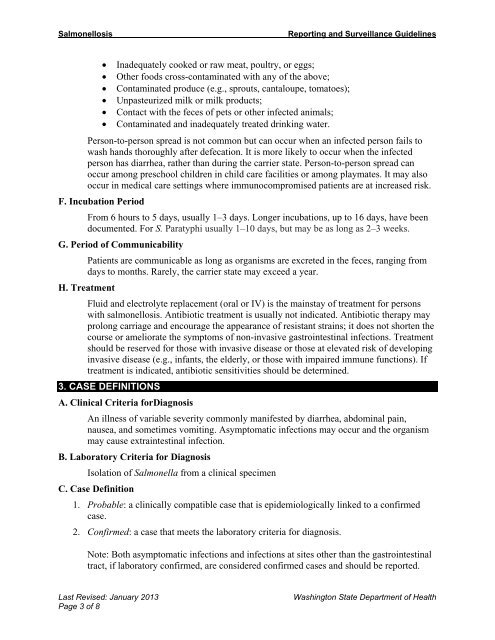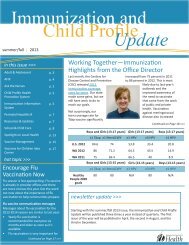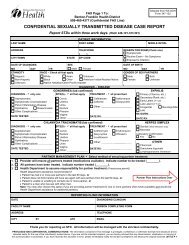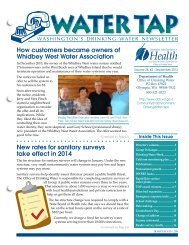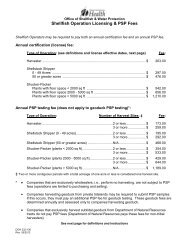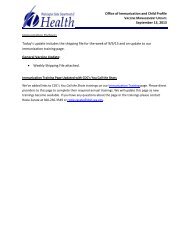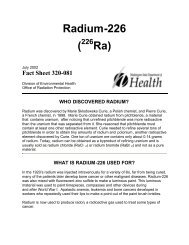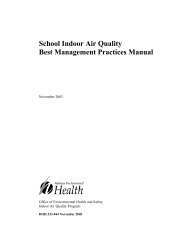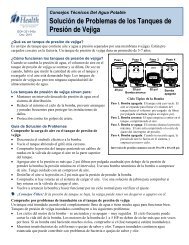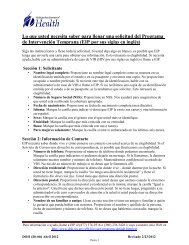Salmonellosis Reporting and Investigation Guideline - Washington ...
Salmonellosis Reporting and Investigation Guideline - Washington ...
Salmonellosis Reporting and Investigation Guideline - Washington ...
You also want an ePaper? Increase the reach of your titles
YUMPU automatically turns print PDFs into web optimized ePapers that Google loves.
<strong>Salmonellosis</strong><br />
<strong>Reporting</strong> <strong>and</strong> Surveillance <strong>Guideline</strong>s<br />
• Inadequately cooked or raw meat, poultry, or eggs;<br />
• Other foods cross-contaminated with any of the above;<br />
• Contaminated produce (e.g., sprouts, cantaloupe, tomatoes);<br />
• Unpasteurized milk or milk products;<br />
• Contact with the feces of pets or other infected animals;<br />
• Contaminated <strong>and</strong> inadequately treated drinking water.<br />
Person-to-person spread is not common but can occur when an infected person fails to<br />
wash h<strong>and</strong>s thoroughly after defecation. It is more likely to occur when the infected<br />
person has diarrhea, rather than during the carrier state. Person-to-person spread can<br />
occur among preschool children in child care facilities or among playmates. It may also<br />
occur in medical care settings where immunocompromised patients are at increased risk.<br />
F. Incubation Period<br />
From 6 hours to 5 days, usually 1–3 days. Longer incubations, up to 16 days, have been<br />
documented. For S. Paratyphi usually 1–10 days, but may be as long as 2–3 weeks.<br />
G. Period of Communicability<br />
Patients are communicable as long as organisms are excreted in the feces, ranging from<br />
days to months. Rarely, the carrier state may exceed a year.<br />
H. Treatment<br />
Fluid <strong>and</strong> electrolyte replacement (oral or IV) is the mainstay of treatment for persons<br />
with salmonellosis. Antibiotic treatment is usually not indicated. Antibiotic therapy may<br />
prolong carriage <strong>and</strong> encourage the appearance of resistant strains; it does not shorten the<br />
course or ameliorate the symptoms of non-invasive gastrointestinal infections. Treatment<br />
should be reserved for those with invasive disease or those at elevated risk of developing<br />
invasive disease (e.g., infants, the elderly, or those with impaired immune functions). If<br />
treatment is indicated, antibiotic sensitivities should be determined.<br />
3. CASE DEFINITIONS<br />
A. Clinical Criteria forDiagnosis<br />
An illness of variable severity commonly manifested by diarrhea, abdominal pain,<br />
nausea, <strong>and</strong> sometimes vomiting. Asymptomatic infections may occur <strong>and</strong> the organism<br />
may cause extraintestinal infection.<br />
B. Laboratory Criteria for Diagnosis<br />
Isolation of Salmonella from a clinical specimen<br />
C. Case Definition<br />
1. Probable: a clinically compatible case that is epidemiologically linked to a confirmed<br />
case.<br />
2. Confirmed: a case that meets the laboratory criteria for diagnosis.<br />
Note: Both asymptomatic infections <strong>and</strong> infections at sites other than the gastrointestinal<br />
tract, if laboratory confirmed, are considered confirmed cases <strong>and</strong> should be reported.<br />
Last Revised: January 2013<br />
Page 3 of 8<br />
<strong>Washington</strong> State Department of Health


